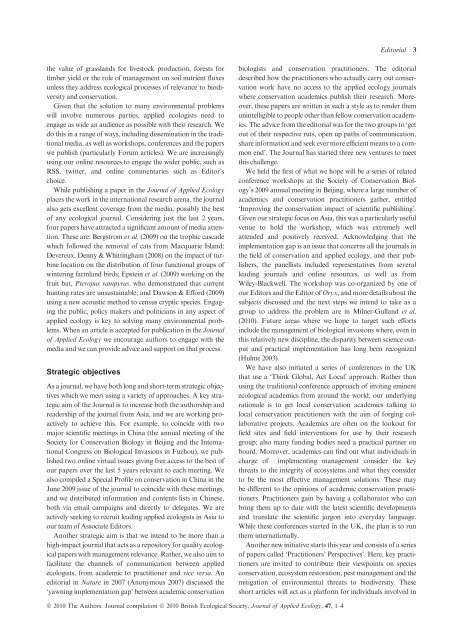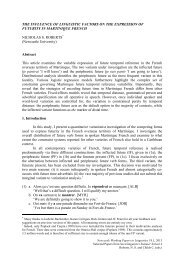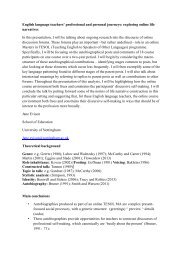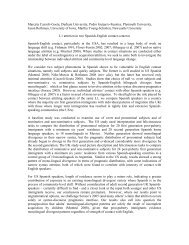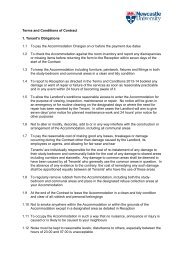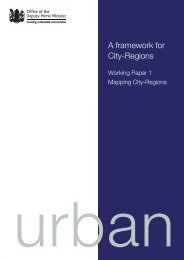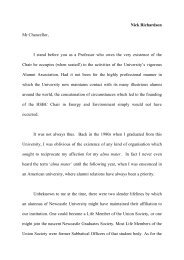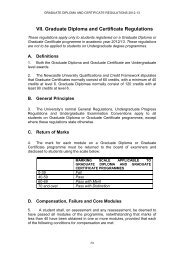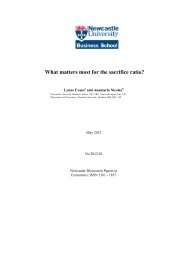Putting applied ecology into practice - Newcastle University
Putting applied ecology into practice - Newcastle University
Putting applied ecology into practice - Newcastle University
You also want an ePaper? Increase the reach of your titles
YUMPU automatically turns print PDFs into web optimized ePapers that Google loves.
the value of grasslands for livestock production, forests for<br />
timber yield or the role of management on soil nutrient fluxes<br />
unless they address ecological processes of relevance to biodiversity<br />
and conservation.<br />
Given that the solution to many environmental problems<br />
will involve numerous parties, <strong>applied</strong> ecologists need to<br />
engage as wide an audience as possible with their research. We<br />
do this in a range of ways, including dissemination in the traditional<br />
media, as well as workshops, conferences and the papers<br />
we publish (particularly Forum articles). We are increasingly<br />
using our online resources to engage the wider public, such as<br />
RSS, twitter, and online commentaries such as Editor’s<br />
choice.<br />
While publishing a paper in the Journal of Applied Ecology<br />
places the work in the international research arena, the journal<br />
also gets excellent coverage from the media, possibly the best<br />
of any ecological journal. Considering just the last 2 years,<br />
four papers have attracted a significant amount of media attention.<br />
These are: Bergstrom et al. (2009) on the trophic cascade<br />
which followed the removal of cats from Macquarie Island;<br />
Devereux, Denny & Whittingham (2008) on the impact of turbine<br />
location on the distribution of four functional groups of<br />
wintering farmland birds; Epstein et al. (2009) working on the<br />
fruit bat, Pteropus vampyrus, who demonstrated that current<br />
hunting rates are unsustainable; and Dawson & Efford (2009)<br />
using a new acoustic method to census cryptic species. Engaging<br />
the public, policy makers and politicians in any aspect of<br />
<strong>applied</strong> <strong>ecology</strong> is key to solving many environmental problems.<br />
When an article is accepted for publication in the Journal<br />
of Applied Ecology we encourage authors to engage with the<br />
media and we can provide advice and support on that process.<br />
Strategic objectives<br />
As a journal, we have both long and short-term strategic objectives<br />
which we meet using a variety of approaches. A key strategic<br />
aim of the Journal is to increase both the authorship and<br />
readership of the journal from Asia, and we are working proactively<br />
to achieve this. For example, to coincide with two<br />
major scientific meetings in China (the annual meeting of the<br />
Society for Conservation Biology in Beijing and the International<br />
Congress on Biological Invasions in Fuzhou), we published<br />
two online virtual issues giving free access to the best of<br />
our papers over the last 5 years relevant to each meeting. We<br />
also compiled a Special Profile on conservation in China in the<br />
June 2009 issue of the journal to coincide with these meetings,<br />
and we distributed information and contents lists in Chinese,<br />
both via email campaigns and directly to delegates. We are<br />
actively seeking to recruit leading <strong>applied</strong> ecologists in Asia to<br />
our team of Associate Editors.<br />
Another strategic aim is that we intend to be more than a<br />
high-impact journal that acts as a repository for quality ecological<br />
papers with management relevance. Rather, we also aim to<br />
facilitate the channels of communication between <strong>applied</strong><br />
ecologists, from academic to practitioner and vice versa. An<br />
editorial in Nature in 2007 (Anonymous 2007) discussed the<br />
‘yawning implementation gap’ between academic conservation<br />
Editorial 3<br />
biologists and conservation practitioners. The editorial<br />
described how the practitioners who actually carry out conservation<br />
work have no access to the <strong>applied</strong> <strong>ecology</strong> journals<br />
where conservation academics publish their research. Moreover,<br />
these papers are written in such a style as to render them<br />
unintelligible to people other than fellow conservation academics.<br />
The advice from the editorial was for the two groups to ‘get<br />
out of their respective ruts, open up paths of communication,<br />
share information and seek ever more efficient means to a common<br />
end’. The Journal has started three new ventures to meet<br />
this challenge.<br />
We held the first of what we hope will be a series of related<br />
conference workshops at the Society of Conservation Biology’s<br />
2009 annual meeting in Beijing, where a large number of<br />
academics and conservation practitioners gather, entitled<br />
‘Improving the conservation impact of scientific publishing’.<br />
Given our strategic focus on Asia, this was a particularly useful<br />
venue to hold the workshop, which was extremely well<br />
attended and positively received. Acknowledging that the<br />
implementation gap is an issue that concerns all the journals in<br />
the field of conservation and <strong>applied</strong> <strong>ecology</strong>, and their publishers,<br />
the panellists included representatives from several<br />
leading journals and online resources, as well as from<br />
Wiley-Blackwell. The workshop was co-organized by one of<br />
our Editors and the Editor of Oryx, and more details about the<br />
subjects discussed and the next steps we intend to take as a<br />
group to address the problem are in Milner-Gulland et al.<br />
(2010). Future areas where we hope to target such efforts<br />
include the management of biological invasions where, even in<br />
this relatively new discipline, the disparity between science output<br />
and practical implementation has long been recognized<br />
(Hulme 2003).<br />
We have also initiated a series of conferences in the UK<br />
that use a ‘Think Global, Act Local’ approach. Rather than<br />
using the traditional conference approach of inviting eminent<br />
ecological academics from around the world, our underlying<br />
rationale is to get local conservation academics talking to<br />
local conservation practitioners with the aim of forging collaborative<br />
projects. Academics are often on the lookout for<br />
field sites and field interventions for use by their research<br />
group; also many funding bodies need a practical partner on<br />
board. Moreover, academics can find out what individuals in<br />
charge of implementing management consider the key<br />
threats to the integrity of ecosystems and what they consider<br />
to be the most effective management solutions. These may<br />
be different to the opinions of academic conservation practitioners.<br />
Practitioners gain by having a collaborator who can<br />
bring them up to date with the latest scientific developments<br />
and translate the scientific jargon <strong>into</strong> everyday language.<br />
While these conferences started in the UK, the plan is to run<br />
them internationally.<br />
Another new initiative starts this year and consists of a series<br />
of papers called ‘Practitioners’ Perspectives’. Here, key practitioners<br />
are invited to contribute their viewpoints on species<br />
conservation, ecosystem restoration, pest management and the<br />
mitigation of environmental threats to biodiversity. These<br />
short articles will act as a platform for individuals involved in<br />
Ó 2010 The Authors. Journal compilation Ó 2010 British Ecological Society, Journal of Applied Ecology, 47, 1–4


